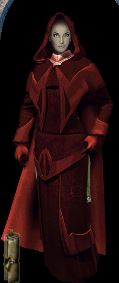Tailoring is the skill which allows a character to make clothing and leather armor, it has much in common with blacksmithing in that training to 70 skill can be done through Bulk Orders interspersed with Tailoring Quests from Heartwood Elves.
When working with leather to make armor, armslore, base properties, material bonuses and runic bonuses also apply.
Creating your tailor
Ultima Online being the sandbox it is, nothing is set in stone. Suggested skills are:
- Tailoring; obviously, select this as a starting skill at 50% (there is no accelerated gain quest for this skill)
- Arms Lore; gives bonuses to exceptionally made items in addition to the normal Exceptional Bonus
- Tinkering; allows you to make your own tools
- Imbuing; a relatively new skill, allows you to add magic properties to your crafted items, either in a controlled way through the imbuing skill or more randomly, but also more powerfully, through Runic Reforging.
- Blacksmithy; not essential, but allows you to add metal armor and weapons to your range
- Mining; only if you also choose Blacksmithy.
An alternative to blacksmith/mining would be carpentry/lumberjacking.
- Carpentry; combines with Tailoring to make some house add-ons and furniture. Such items are listed on the ‘Carpentry Items‘ page.
- Lumberjacking; only if you also choose carpentry
- magery or chivalry; mostly for travelling and healing if you should run into anything hostile. Magery if you want to be able to retaliate.
Basics
You will need the tools of the trade, sewing kits. These can be bought from npcs, though exceptionally crafted ones made through tinkering skill will have more charges. You will also need a pair of scissors. optional extras are a dye tub, bought from the tailor and a salvage bag which can be bought from a provisioner NPC.
The other important tools you may choose to use are the spinning wheel and loom
Using these two items will allow you to create your own cloth, though you can also buy bolts of cloth from tailor and weaver npcs. They can be found, and used, in most tailor shops or if you have sufficient carpentry skill and a house to put them in you can make, and use, your own.
Before you can use the spinning wheel, you need something to spin. This can be:
- flax, bought from the Tailor NPC or harvested from plants grown by players
- cotton, bought from the Tailor NPC or picked from cotton fields in Moonglow or Delucia
- wool, sheared from sheep. Use any sharp weapon, dagger, axe etc, double click it and target a LIVE sheep to obtain 3 piles of wool.
Sheep can be found wandering the land. The most reliable concentrations of sheep are in the fields to the far East of Haven Island (beware brigands) in fields around Yew and near Delucia.
Using the Spinning Wheel:
Double click on the raw material (flax, cotton or wool) and target the wheel hub. One pile of wool yields 3 balls of yarn, whereas a bundle of flax/bale of cotton each yield 6 spools of thread.
Using the Loom:
Double click the stack of thread/yarn and target the loom near the lower crossbar. After selecting the loom, you will get a progress message. Keep double clicking the thread/yarn and selecting the loom. If your thread or yarn is in a stack, you can just use a “Last Object, Last Target” macro. After the fifth spool or ball, the bolt of cloth will appear in your backpack. Five thread/yarn will produce one bolt of cloth and it doesn’t matter if you mix thread and yarn.
Getting Started
Now that you have not only tools, but resources to craft with you may begin. It is strongly suggested that you begin training by making Bulk Orders for the tailor NPC. Not only will this allow you to gain skill, you will also be paid in gold for your efforts.
- Place cloth in your backpack
- Double-click on your sewing kit; the crafting menu will come up on the screen. It has 3 areas; Left (the categories), Right (the items within a category), and Bottom (Options)
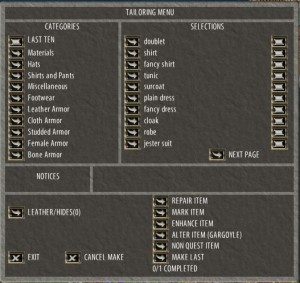
- If necessary, set your options, using the choices in the bottom section of the menu.
- Leather/Hides – this only becomes necessary when you are able to use the colored leather types, as you have to change the leather type to that which you intend to craft with.
- repairing an existing item
- marking your exceptional items (only apply after reaching 100 skill)
- enhancing an existing item (again, only applies to the colored leathers, being applied to a regular leather item
- Altering a human or elven styled item to one suitable for a gargoyle (see Altering)
- a ‘toggle’ for marking items as ‘quest items’. Use this when filling Heartwood quests.
- and a shortcut “Make Last” button, which will repeat your last attempted item.
- Choose the appropriate category from the left-hand side of the craft menu.
- Select the item you wish to create from the right-hand side of the menu. You may have to page through to find the item you want, by using the arrow (if present) in the bottom corner of the right-hand side.
- Clicking on the box to the right of the item you wish to create will open a further page of the menu with details of the materials and skill required to make the item together with other crafting options
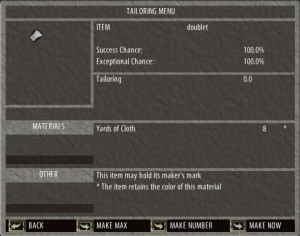
- On this page you can choose ‘make now’ if you only require a single item, ‘make number’ if you are filling a bulk order or Heartwood quest, or ‘make max’ if you want to create as many as you have resources for in your pack.
- If successful, the crafted item will appear in your backpack.
Note:
- You will not be able to craft any items if your backpack already contains the limit of 125 items. You can craft in a container inside your backpack, but if that container goes over 400 stone weight, any items that would go over 400 will fall to the floor.
- If you are crafting from cloth, and have multiple colors of cloth in your pack (even if in different containers), you will be asked EVERY item, during crafting, which cloth to use, and be required to target it. Now you discover the reason for the suggested inclusion of a dye tub in your ‘tools’. Use it, without dyes, on any colored cloth you acquire to turn it all to the default color, or put colored cloth you wish to keep away in your bank.
Working in Leather
Regular Leather can be bought from tannor or furtrader NPCs, though not as easily as cloth, since only some towns have tanner and furtrader NPCs. The tanner sells cut leather, the furtrader sells hides. Hides are much heavier than cut leather and will need to be cut with scissors before you can work with them.
You could, as with cloth, harvest your own leather. The amount of leather gained from a particular creature depends on what race your character is and where you kill it.
- A human char will get 10% more leather from a creature than an elf or gargoyle
- A creature killed in Felucca gives double the amount of one killed elsewhere.
Note: the carcass must be intact, one that has been drained for spirit speak or animated by a necromancer will not give leather. Nor can you kill and skin a bonded pet.
Carving a carcass is done in much the same way as shearing a sheep, using any sharp weapon. On opening the corpse you will find your carving has resulted in a pile of hides, some raw ribs and sometimes other items, depending on the creature type. Dragons, for example, give leather, dragon blood and dragon scales. Hides weigh 5 stone each and must be cut with scissors.
There are three weapons that are greatly favoured for leather gathering because they cut the leather as it is gathered, thus giving cut leather instead of hides.
A skinning knife, if equipped will do this. You would need to have your paperdoll open in order to double click the item before targetting the corpse to use this. A butcher’s war cleaver need not be equipped and can be double clicked in your back pack. The third item is the Harvester Blade obtained through the Huntmaster’s Challenge, this item also gives a bonus to the leather amount obtained. All these items will place the leather directly into your packpack within certain restrictions. If the leather (as hides) would put you over the default container weight limit of 400 stones, the cut leather will stay in the corpse. It is therefore advisable, if using either of these items, to check the corpse to be sure that you have actually received the leather you carved.
Skinning knives can be bought from a tinker or tanner npc or made using the tinkering skill. Butcher’s war cleavers can not be bought from NPCs, they are made by a Blacksmith who has read the appropriate recipe from Heartwood.
There is quite a long list of animals and some monsters which give plain leather but the most frequently farmed are Cows and Bulls near Delucia; Polar Bears and Walrus on Dagger Island or Lost Lands; or Gaman in Tokuno. They yield leather as follows:
| Trammel | Felucca | |||
|---|---|---|---|---|
Animal |
For Elf or Gargoyle |
For Human |
For Elf or Gargoyle |
For Human |
| Cow | 12 | 14 | 24 | 28 |
| Bull | 15 | 17 | 30 | 34 |
| Walrus | 12 | 14 | 24 | 28 |
| Polar Bear | 16 | 18 | 32 | 36 |
| Gaman | 12 | 14 | No spawn | |
Colored leathers can not be bought from NPCs, and can only be obtained from monster corpses. Some players hunt and sell the leather they gather. This can sometimes be bought from player vendors, or commodity stalls in New Magincia.
Spined Leather: The easiest colored leather to get and, at 65 skill, the first you will be able to work. The most frequently hunted sources of this, though not the only ones, are Lizardmen, Despise in Felucca, Sleeping Dragon champion spawn in Isamu-jima, or Crane Marsh, at the southernmost tip of Homare-jima, Tokuno; Giant Serpents and Alligators found in the jungle areas south of Trinsic and the southern, jungle islands; Ratmen of all varieties. You might also try Lowland Boura in Ter Mur. They yield leather as follows:
| Trammel | Felucca | |||
|---|---|---|---|---|
Animal |
For Elf or Gargoyle |
For Human |
For Elf or Gargoyle |
For Human |
| Lizardman | 12 | 14 | 24 | 28 |
| Giant Serpent | 15 | 17 | 30 | 34 |
| Alligator | 12 | 14 | 24 | 28 |
| Ratmen | 8 | 9 | 16 | 18 |
| Lowland Boura | 20 | 22 | No spawn | |
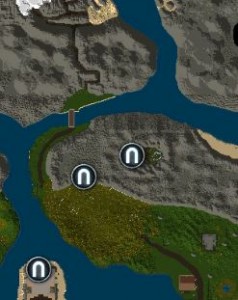 Horned Leather:Workable at 80 skill, this leather was traditionally gathered from Wyverns and Drakes in Destard and Wind – but the introduction of the Greater Dragon raised the risk level rather. Drakes and Wyverns can be found, without accompanying dragons, in Ilshenar in the mountain passages shown at the top of the map, right.
Horned Leather:Workable at 80 skill, this leather was traditionally gathered from Wyverns and Drakes in Destard and Wind – but the introduction of the Greater Dragon raised the risk level rather. Drakes and Wyverns can be found, without accompanying dragons, in Ilshenar in the mountain passages shown at the top of the map, right.
Unicorn and Kirin also yield horned leather, but as these are ‘blue’ monsters hunting them will give negative karma. Ter Mur offers a further source of the leather from High Plains Boura, Raptor or Toxic Sliths. Sea serpents, normal, deep sea and crystal, also yield horned leather:
Barbed Leather: The highest level of leather, in that it adds the most resists to an item, this leather is not workable until 99 skill. It comes from the corpses of Nightmares and all of the larger dragon types, Greater Dragons, Shadow Wyrms, Ancient Wyrms, White Wyrms and Serpentine Dragons. Of these the Nightmare, Dragon, Serpentine Dragon and White Wyrm are probably the least deadly opponents, however the Serpentine Dragon, like Kirin and Unicorns, gives negative karma and the Dragon is usually accompanied by the more deadly Greater Dragon. They each yield leather as follows:
One of the more unusual armor types in your inventory is ‘bone armor’. This is included in the range of items required by NPC’s to fill BODs and requires both leather and bones to craft it. You can buy bones from NPCs in Ter Mur, since they are also a reagent for the skill ‘Mysticism’.
Monsters that have ‘bones’ in their inventory have them as part of a ‘body parts’ drop. You may get bones, or you may get a leg, head, arm or torso. There are a variety of bones, so the drop chance is roughly 50%. Bones, like leather, must be cut before they can be used. This is done with scissors, and can be done by ‘recycling’ them with a salvage bag. If you collect your bones in a salvage bag the whole pile can be cut at once, when cut the bones will stack. There is, however, one type of bone dropped that can not be cut and therefore is useless for tailoring, a skull.
The most popular sources for bones are zombies, in grave yards; shadow wisps, in Ilshenar, part of the ‘oaks’ champion spawn near Spirituality Moongate; Ant lions, in the solen hive; Giant Serpents in jungles. Higher level monsters, requiring a more skilled hunter are Oni, Revenant Lion, Tsuki Wolf and Rune Beetles.
(Note: When altered to Gargoyle version bone armor becomes stone, repaired via Masonry)
Recipes
Some items cannot be crafted until the tailor has read a recipe, the first recipes come from quests given by elves in Heartwood, marked in the tailor craftables table (HEQ). Recipes marked (ToL) are a random drop from killing creatures in Eodon, the recipe for Cuffs of the Arch Mage is a drop from Doom Gauntlet. This item can be converted to a gargoyle equivalent by visiting Vrulkax the Exalted Artificer at the Crafting Plaza in the Royal City. Items presented to Vrulkax must be in full repair. Krampus Minion Hat, Boots and Talons recipes are from Krampus Encounter, December 2018. Further recipes were added Autumn 2019, plain versions of the 6 new items are dropped by Corgul the Soulbinder, Osiredon the Scalis Enforcer and Charybdis. Artifact versions from the Halloween event Treasures of the Sea.
Arcane Clothing
Tailors of 60 skill and above have the ability to use Arcane Gems on certain pieces of clothing and thus create Arcane Clothing.
These gems are found as loot on Controllers, Exodus Minions, Exodus Overseers, Juka Mages and Juka Lords, also occasionally on Golems.
Arcane clothing allows you to cast spells of Mysticism Magery or Necromancy without having the required reagents. Instead it uses charges that are put on it by the gems, one charge per spell. The number of charges imparted to the clothing item depends on the tailoring skill of the character that applies the gem.
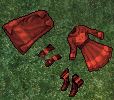 There are 4 items of clothing that can be Arcane: a robe, a cloak, thigh boots and plain leather gloves. These must be crafted of Exceptional quality; at the minimum skill of 60 there is only a 7% chance to make exceptional leather gloves without a talisman. To use a gem on an item, double click the gem and target the item.
There are 4 items of clothing that can be Arcane: a robe, a cloak, thigh boots and plain leather gloves. These must be crafted of Exceptional quality; at the minimum skill of 60 there is only a 7% chance to make exceptional leather gloves without a talisman. To use a gem on an item, double click the gem and target the item.
The number of charges per item at 60 skill is 12, this number goes up by 1 for each 5 points of skill gained to a total of 24 at legendary (120) skill. Once imbued by a gem the maximum number of charges is set, so a robe made by a 60 skill tailor and imbued with 12 charges will only ever have 12 charges, a legendary tailor re-charging the robe will not increase that number.
When all the charges are used up the arcane item loses its color and becomes the default cloth/leather color. It can be recharged by targeting it with another arcane gem. The tailor that made the item, or one of equal or higher skill, can re-charge it fully, but even a non-tailor character can restore some of the charges. Example: on an item with a maximum charge level of 24 a non-tailor can restore 19 charges.
Warning: applying an arcane gem to an item will have the following negative effects:
- Remove ‘blessed’ from any blessed item
- Reduce resists on leather gloves to ‘base properties’ level (2/4/3/3/3)
- Remove any re-forged or imbued magic properties
Arcane clothing items can not be blessed, but can be insured; can not be reforged, but can be imbued after the gem has been applied.

